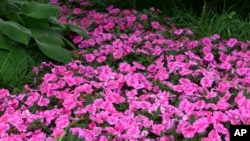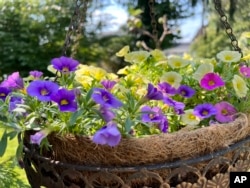Record-breaking heat is affecting plants in many places around the world. But gardening expert Jessica Damiano says selecting the right plants and a little care could save them.
Damiano wrote recently that her tomato plants have not developed much in the past few weeks, but her flower garden is doing very well. Despite temperatures over 37 degrees Celsius in the New York area, Damiano said she has watered her flower garden just two times this summer.
Choosing heat-tolerant plants
Damiano says that in extreme heat, and when that heat is dry, soil moisture evaporates quickly. Plants will turn to their own limited moisture storage when they need water. This requires them to use energy toward cooling and using water. This energy should be spent on growth, flowering, fruiting and reproducing. The stress often completely weakens the plant.
When plants are native to an area, they naturally develop deep, large root systems. These systems permit the plants to reach distant sources of moisture when the nearby area dries out.
Many foreign plants, including most plants that live for just one year, have root systems that are not deep. This means they must depend on the top few centimeters of soil for all of their water needs. When it dries up, so do they.
To save water, money, and effort, Damiano suggests researching which plants are native to your area. Some native plants for Damiano’s New York area include yearly returning plants like bee balm, black-eyed Susan, and purple coneflower.
But she also has some non-native plants that tolerate both the heat and dry weather. She keeps yearly returning plants, or perennials, in her beds, and plants that last one growing season, or annuals, in containers.
Damiano says the flowering plant “Bounce” impatiens live up to their name in her containers. They bounce back from being weakened by a hot and dry day after being watered.
Plants like sedums, or stonecrop, are highly tolerant to dry, hot weather. This is because their leaves store moisture and release it as the plants need it. Other plants that can deal with heat include beardtongue, catmint, floss flower, lavender, and moss rose.
Planting advice
When planting, Damiano says she always dusts root balls with fungi called mycorrhizae. It helps grow roots and helps plants deal with severe heat. She also treats her plants once a month with two products: a seaweed-containing fish mixture and a vitamin-hormone-kelp product.
Seaweed and kelp are plants that grow in water. They have been shown to help other plants in difficult environments. These additions also help plants grow quickly after dividing and transplanting.
Finally, Damiano says the last addition is a good amount of mulch on top. Mulch not only keeps things looking clean, but it also helps to keep soil moisture and soil temperatures even. And it keeps unwanted plants from growing. Mulch can mean the difference between plant life and death when it gets hot.
I’m Gregory Stachel.
Jessica Damiano reported this story for The Associated Press. Gregory Stachel adapted it for VOA Learning English.
__________________________________________________
Words in This Story
garden – n. an area of ground where plants (such as flowers or vegetables) are grown
moisture – n. a small amount of a liquid (such as water) that makes something wet or moist
tolerate – v. to experience (something harmful or unpleasant) without being harmed
bounce back – phr. v. to return quickly to a normal condition after a difficult situation or event
fungus – n. any one of a group of living things (such as molds, mushrooms, or yeasts) that often look like plants but have no flowers and that live on dead or decaying things
mulch – n. a material (such as straw, leaves, or small pieces of wood) that is spread over the ground in a garden to protect the plants or help them grow and to stop weeds from growing
__________________________________________________
What do you think of this story?
We want to hear from you. We have a new comment system. Here is how it works:
- Write your comment in the box.
- Under the box, you can see four images for social media accounts. They are for Disqus, Facebook, Twitter and Google.
- Click on one image and a box appears. Enter the login for your social media account. Or you may create one on the Disqus system. It is the blue circle with “D” on it. It is free.
Each time you return to comment on the Learning English site, you can use your account and see your comments and replies to them. Our comment policy is here.










Forum